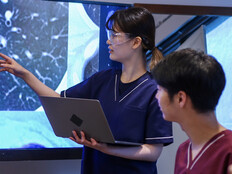Next-Generation Cyberspace
The high-speed, high-bandwidth, members-only Internet2 network is transforming the learning experience in higher education — and that’s only the tip of the iceberg.
When students at the University of Southern California go to a music class, they enter a dimension of sight and sound that would have been unimaginable a decade ago. Some of the world's leading maestros and musicians coach students and offer performances that would dazzle music aficionados.
“Virtual technology has transformed learning. It has created new opportunities,” observes Brian K. Shepard, assistant professor of pedagogical technology in the Thornton School of Music at USC.
Plugging into Internet2 (internet2.edu), Shepard is able to take students where no music class has gone before. Within this virtual world, a world-class musician in London or Tokyo becomes part of the classroom. Digital video and high-fidelity audio stream across thousands of miles and provide an unsurpassed level of interactivity.
“It's as if everyone is situated in the same room and geographical differences have vanished,” Shepard says.
Welcome to the next generation of learning and instruction. Although the Internet has emerged as an invaluable tool for universities and colleges worldwide, more than 200 schools have made the jump to Internet2 – along with laboratories, government agencies and corporations. Some are using it to engage in high-definition videoconferencing, others to teach virtual surgery and still others to create telephoneimmersive tools that let researchers use specialized goggles to visualize multidimensional data sets in 3-D.
All are tapping into bandwidth that ranges between 10 gigabits per second and 40Gbps, realizing a quality of service that isn't possible on the conventional Internet. More advanced networking guarantees that packets will arrive while the Internet relies on a “best-efforts” approach – which means the data may or may not arrive at the destination. In fact, standard e-mail, Web browsing and commerce between organizations isn't allowed over Internet2. That data is routed to the public Internet.
Computing on a High Note
A growing number of institutions are looking to take their computer-laced teaching and research to the next level via Internet2. Although some schools want to improve performance for existing applications, others are eyeing an array of futuristic capabilities. At USC, for example, assembling musicians and students virtually has proven a boon – with the likes of conductor and composer Michael Tilson Thomas and composer Joan Tower performing and discussing their works with students.
Not only can students watch and hear performances, they're also able to discuss techniques and ask questions during sessions. In some cases – such as during a master class – the school uses a multicast to relay the video and audio to students and others across the campus or around the world.
“The cost of physically bringing the person to the class would be costprohibitive,” Shepard says. “A virtual session brings an entirely new dimension to education. It broadens the learning horizon.”
USC's music lab relies on an impressive array of equipment to put Internet2 into action, including high-end digital video cameras, a professional-quality digital video recorder, LCD monitors and display screens, multiple video projectors, an audio mixer and microphones. Shepard positions the projectors and display screens to create an illusion that the guest speaker or performer is in the same room. The video and audio travel across the network at a rate of 30 megabits per second.
Gerry Kaufhold, principal analyst for In-Stat, a market research and consulting firm in Scottsdale, Ariz., believes Internet2 is ushering in a new era of collaborative learning. High-definition videoconferencing and multicasting, grid computing, advanced simulations and virtual telemedicine are just a few of the emerging applications, he says.
“Internet2 is introducing some revolutionary applications because it supports bandwidth and quality of service that aren't possible on the conventional Internet,” says Kaufhold.
Operating at the Speed of Light
Another institution on the leading edge of Internet2 technology is Stanford University's School of Medicine. It now uses the highspeed network to develop surgical simulators for training students. Although robotic simulators are nothing new – Stanford and other schools have used them for several years to help students learn the intricacies of surgery – the ability to control robotic devices from as far away as Australia or the United Kingdom has just taken off.
“Participants share the view of a 3-D anatomical structure and use a virtual tool that feels like the real thing in a person's hands. It creates the sensation of feeling,” says Parvati Dev, director of Stanford's Summit Lab. In addition, audience members can wear special goggles to view the surgical simulation. Despite its seemingly new-age, end-user applications, the system runs on a high-end PC that runs Microsoft Windows and proprietary software developed by Stanford. It requires a 40Mbps connection to create a near real-time link between two locations.
Laurie Burns, executive director of member and partner relations for the Internet2 Consortium, says such capabilities are only a few of the applications that consortium members are working on and portend the network's future uses. As Internet2 bandwidth increases, more powerful applications are likely to follow, she says, in areas as diverse as astronomy, medicine, digital archiving, grid computing, engineering and design, and virtual reality simulations. Says In-Stat's Kaufhold: “The potential of Internet2 is limited only by bandwidth and imagination.”
Internet2
Consortium at a Glance
- Founded: In 1996, with 34 original members
- Status: Private, nonprofit
- Mission: To foster advanced networking while introducing new network capabilities, including quality of service, multicasting, and next-generation protocols and applications
- Current membership: 300-plus organizations (205 universities, 72 corporate members and 44 affiliate members)
- Sample applications: High-definition video multicasts, videoconferencing, grid computing, telesurgery, simulations, virtual reality databases and collaboration
- Number of users: 10 million
- Network: Originally built on two high-speed optical backbones; being upgraded to boost speeds and improve quality of service
- Bandwidth: 10Gbps to more than 40Gbps Future bandwidth: Upwards of 190 terabits per second








